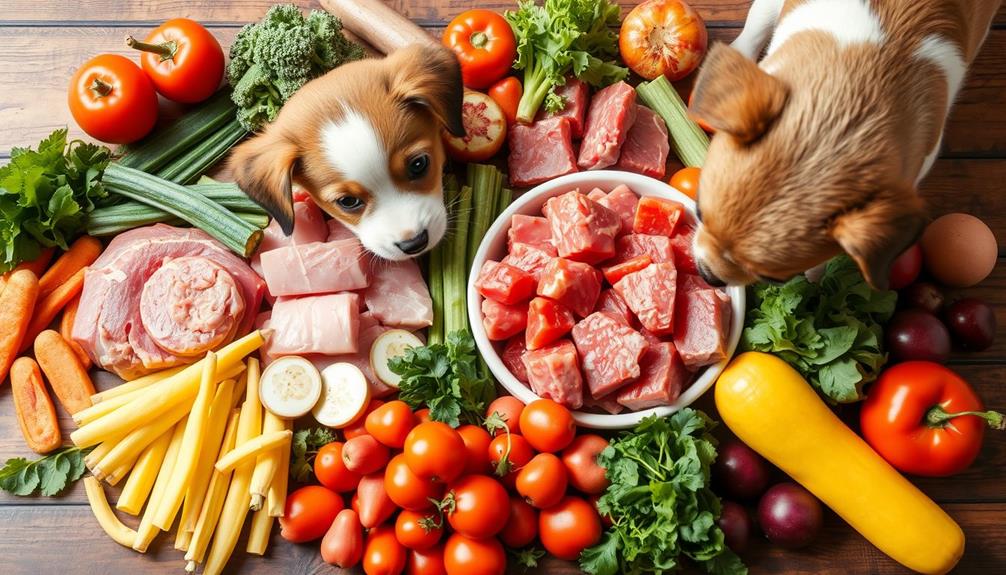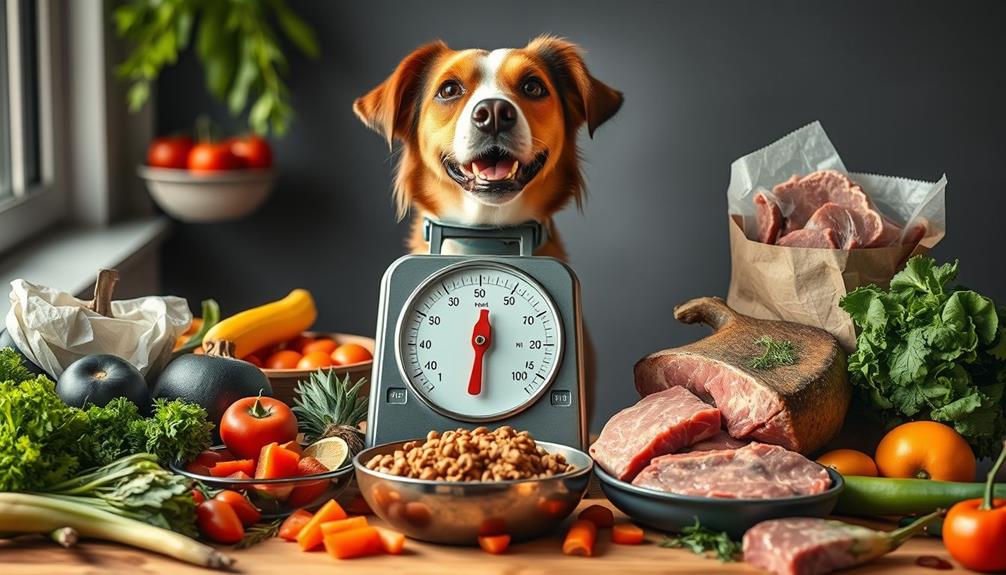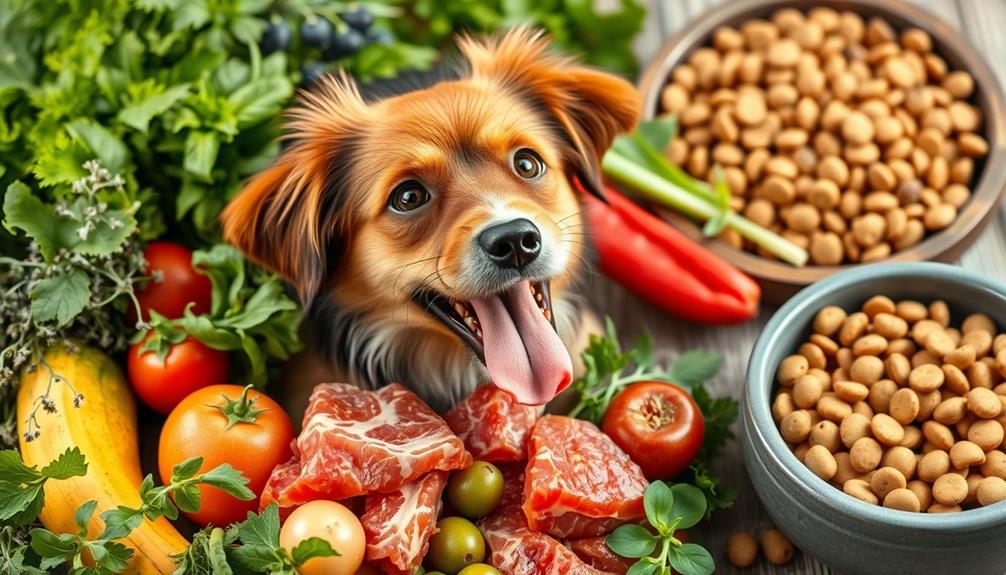To determine how much raw food to give your dog, weigh their body and adjust based on activity level. Generally, you should feed adult dogs 2% to 3% of their body weight daily. Active dogs may need up to 3%, while smaller breeds can require more—up to 5-6%. Split this daily portion into two meals for better digestion. If you're introducing a raw diet, start gradually with a mix of current and new food. Monitoring their weight and health will help guarantee a smooth shift and ideal nutrition. There's much more to ponder for a successful raw feeding journey!
Key Takeaways
- Feed adult dogs 2-3% of their ideal body weight in raw food, adjusting based on activity levels.
- Small dogs (up to 5 lbs) may require 5-6% of their body weight in raw food daily.
- Gradually introduce raw food, starting with a 25% mix for three days before increasing to full raw.
- Monitor weight weekly to adjust food intake and ensure healthy growth, especially in puppies.
- Ensure a balanced diet with muscle meat, organ meat, and ground bone to avoid nutrient deficiencies.
Benefits of a Raw Diet
Embracing a raw diet for your dog can lead to remarkable improvements in their overall health and well-being. One of the most significant benefits is improved digestion. Raw diets often result in better nutrient absorption, meaning your dog gets more out of their food, which contributes to better overall health.
Additionally, providing a varied diet with fresh ingredients, similar to how you'd care for pets like hamsters, can enhance nutrient intake and health benefits. As a bonus, many pet owners notice their dogs have a shinier coat and healthier skin, thanks to the natural fats and nutrients found in raw ingredients proper diet for pets.
You may also find that switching to a raw diet helps reduce allergies and skin issues. Dogs often experience fewer allergy symptoms, leading to a happier and more comfortable pet.
Additionally, a raw diet can enhance energy levels. With the right nutrients fueling their bodies, your dog will likely feel more vibrant and active.
Another important aspect is dental health. Chewing raw food can help naturally clean their teeth, reducing plaque buildup and promoting healthier gums.
Even if you only incorporate a small amount of raw food—around 25% of their diet—you could see significant improvements in your dog's health and wellness.
Portion Guidelines for Dogs
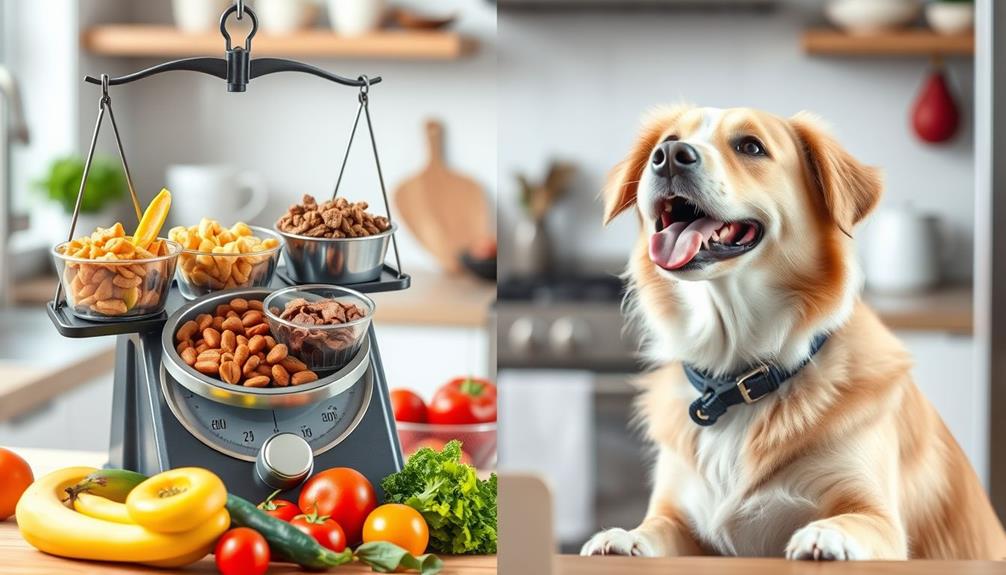
Determining the right portion of raw food for your dog is essential for their health and well-being. The recommended amount of raw food to feed is generally between 2% to 3% of your dog's body weight daily. This can vary depending on factors such as your dog’s age, activity level, and overall health. It’s important to consult with a veterinarian or a canine nutritionist to determine the best portion size for your individual dog. Raw food for dogs can provide them with essential nutrients and enzymes that may be lost during the cooking process, promoting better digestion and overall health.
To keep your dog engaged and satisfied, consider incorporating healthy dog snacks alongside their raw food. You'll want to adjust this depending on their activity level and health condition. For instance, if you have a 25-pound dog, you should feed them approximately 0.5 pounds (8 ounces) of raw food each day.
Active dogs might require up to 3% of their ideal weight, while less active dogs should stick to about 2% to 2.5%.
Keep in mind that smaller dogs need a higher percentage of their body weight compared to larger breeds; dogs weighing up to 5 pounds may need around 5-6% of their body weight.
To promote better digestion and nutrient absorption, it's best to divide your dog's daily portion into two meals.
Starting a Raw Diet
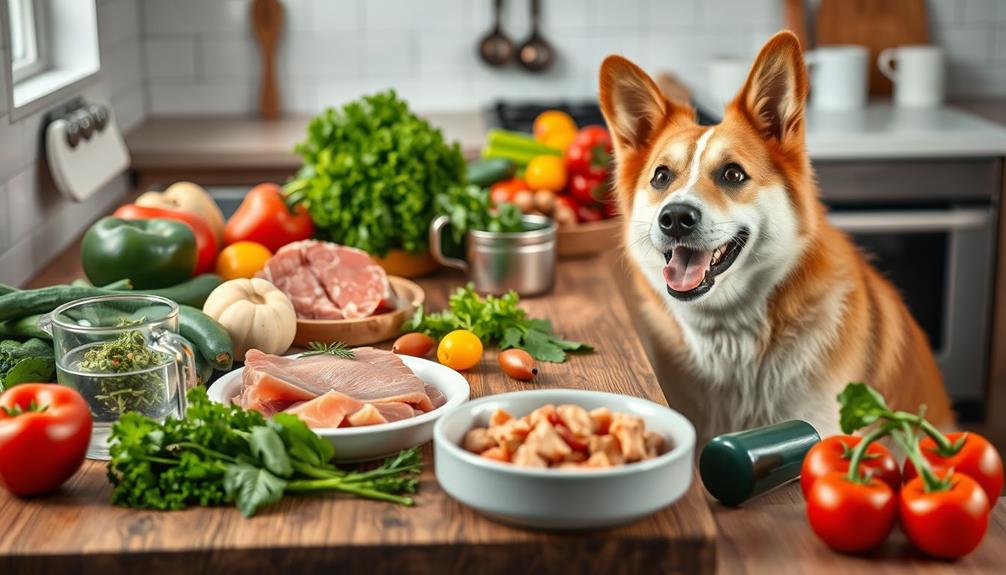
Starting a raw diet for your dog can be an exciting journey toward better health, but it's important to ease into it gradually. Begin by mixing 25% raw food with 75% of their current diet for the first three days. After that, increase the raw portion slowly.
For adult dogs, aim to feed them 2-3% of their ideal body weight in raw food daily, adjusting based on their activity level. It's also essential to take into account common types of cold medications that may affect your dog's immune system if they're unwell during this change.
Puppies require notably more food—about 2-3 times as much based on their current weight—and should be fed 3-4 times a day.
Monitoring your dog's response during this change is key. You might notice some initial weight loss, likely due to water weight, which is normal in the first week.
If your dog has existing health issues or sensitivities, it's wise to consult your veterinarian throughout the process. They can provide tailored feeding guidelines to guarantee your dog's well-being.
Quality of Ingredients
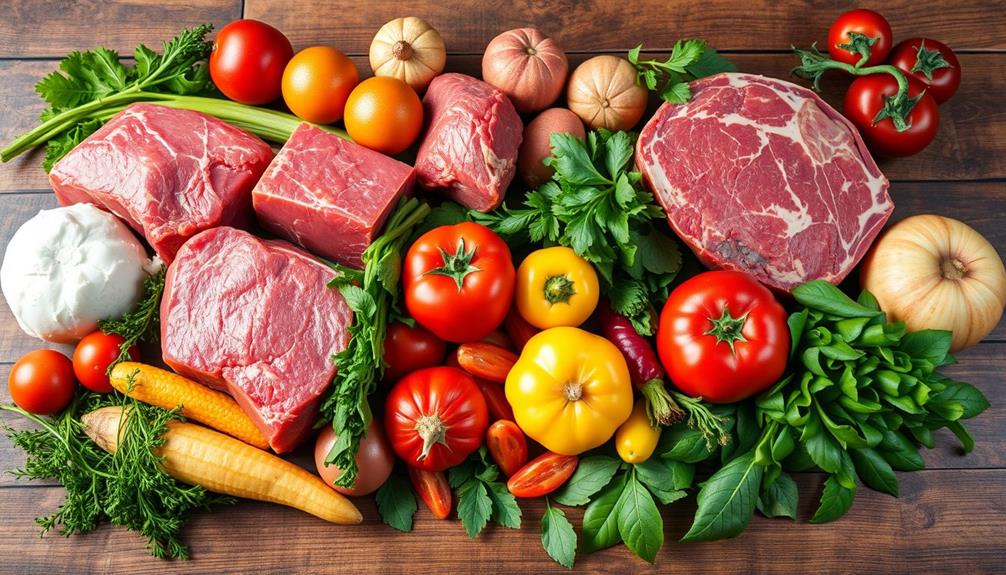
The quality of ingredients in your dog's raw food is crucial for their health and well-being. Choosing high-quality ingredients guarantees that your pup gets the necessary nutrients they need without harmful additives.
It's important to remember that a diet rich in antioxidants can benefit overall health, similar to how Cranberry Juice Consumption supports human wellness. Here are some key points to take into account:
- Locally sourced ingredients are fresher and support local agriculture.
- Always opt for hormone-free meats from animals raised without antibiotics to promote your dog's health.
- A balanced raw diet should include muscle meat, organ meat, and finely ground bone to avoid fillers and artificial additives.
- Check the company's reputation for ingredient quality; it reflects their commitment to transparency and nutritional adequacy.
- Confirm proper quality control measures during food preparation, which are crucial for safety and nutrient retention.
Feeding Adult Dogs

When you feed adult dogs, it's essential to tailor their diet based on their specific needs. Generally, you should provide about 2-4% of their body weight in raw food daily. For active dogs, aim for around 3%, while less active dogs require closer to 2%.
For example, a 50-pound adult dog would need between 1 to 2 pounds of raw food each day, ideally split into two meals. Incorporating fresh ingredients can enhance the overall diet, and some important oils, such as eucalyptus oil, may even promote healthier digestion.
Remember, smaller dogs need a higher percentage; those weighing 5-10 lbs might need 4-5% of their body weight daily. It's important to monitor your dog's weight and adjust the amount you feed as necessary. Factors like age, breed, and metabolism play a significant role in determining their dietary needs.
The raw diet can lead to less food intake compared to kibble since it offers enhanced nutrient bioavailability. Keep an eye on your dog's health, and be ready to adjust feeding frequency if needed.
Raw Food for Puppies
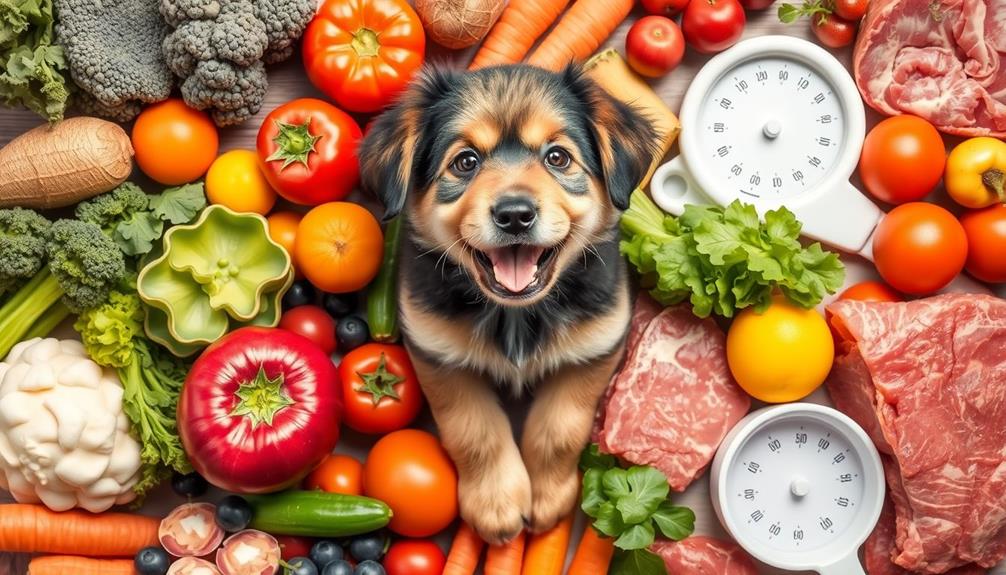
When it comes to feeding your puppy, getting the frequency and portion sizes right is essential for their growth.
Puppies require a balanced diet that supports their developing bodies and energy needs, which can be influenced by factors such as key domains of development in psychology.
You'll want to provide meals that account for at least 5% of their body weight daily, split into 2-3 feedings.
Plus, keeping an eye on their weight and growth will help you adjust their food intake as needed.
Feeding Frequency Recommendations
Regularly feeding your puppy the right amount of raw food is essential for their growth and development. To guarantee they thrive, it's important to follow proper feeding frequency recommendations.
Young puppies typically need 3-4 meals per day, while older puppies can be converted to 2 meals. As a general guideline, you should feed your puppy about 2-3% of their ideal adult weight daily, which aligns with maintaining a healthy budget for pet expenses.
For example, a 10-pound puppy would require approximately 0.2 to 0.3 pounds of raw food daily. Understanding the importance of a balanced diet is as vital as learning about common financial terms to manage your overall spending.
Here are some tips to help you establish a feeding routine:
- Monitor weight regularly to guarantee your puppy is growing as expected.
- Adjust feeding amounts based on their growth and activity levels.
- Gradually introduce a variety of raw recipes for a balanced diet.
- Keep the feeding schedule consistent to help with digestion.
- Always guarantee fresh water is available to keep your puppy hydrated.
Portion Size Guidelines
Establishing the right portion sizes for your puppy's raw food diet is crucial for their growth and health. You should feed your puppy about 2-3% of their ideal adult weight daily, or roughly 10% of their current weight. For example, if your puppy weighs 10 pounds, they'll need about 1 pound of raw food each day.
Incorporating a balanced diet rich in fruits, vegetables, and whole grains can also support their overall development. Splitting this into 3-4 smaller puppy meals for very young pups, or 2-3 meals for older ones, helps guarantee they get the nutrients they need throughout the day.
As you introduce raw food, start with 1-2 recipes and increase variety gradually. This helps your puppy adjust to their new diet without digestive issues. It's important to keep a close eye on their weight and overall health.
Regularly monitoring weight allows you to adjust feeding amounts as necessary to support healthy growth. If your puppy seems to be gaining or losing weight too quickly, modify their portion size accordingly.
Monitoring Growth Progress
To guarantee your puppy grows at a healthy rate on a raw food diet, it's crucial to monitor their weight and adjust feeding amounts as needed. Puppies require about 5% of their current body weight in raw food daily, split into 2-3 meals. This helps support their rapid growth and development.
Additionally, it's important to take into account the financial aspects of pet care, guaranteeing you budget for high-quality raw food options that meet your puppy's nutritional needs, similar to how one would evaluate financial planning for elderly care.
Here's how to effectively monitor your puppy's growth progress:
- Weigh your puppy weekly to track their weight changes.
- Adjust feeding amounts based on growth stages; younger puppies need more food than older ones of the same weight.
- Ensure meals are balanced by gradually introducing a variety of recipes to prevent picky eating.
- Observe your puppy for signs of healthy growth—energy levels, coat condition, and overall demeanor.
- Keep a feeding log to help you remember what and how much they eat.
Transitioning to Raw Food
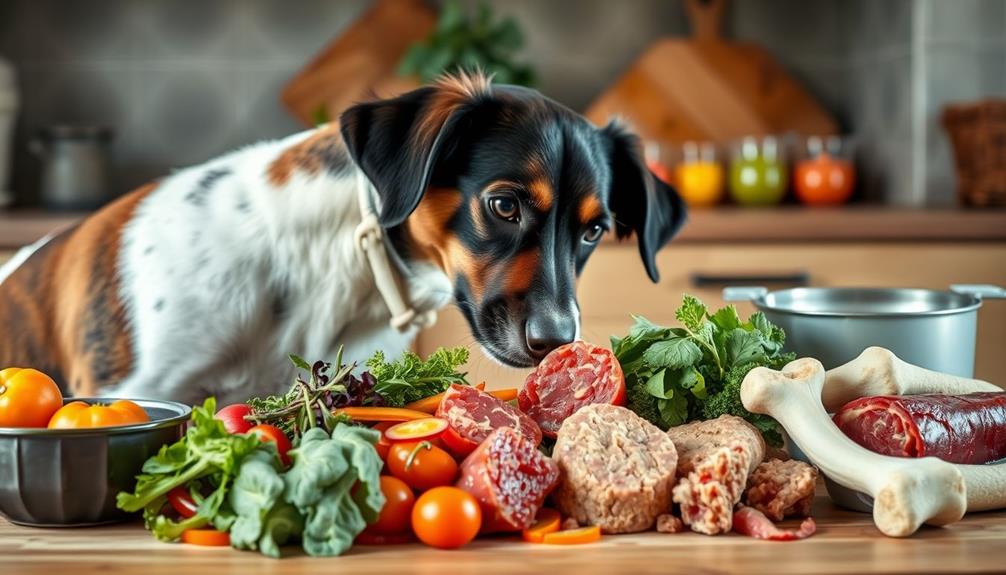
Adjusting your dog to a raw food diet should be gradual to avoid digestive issues.
It's important to monitor your dog's overall health and behavior during this adjustment, as some dogs may benefit from a more gradual shift, similar to how preppers master the art of bug out bags.
Start with a mix of 25% raw food and 75% of their current diet, then monitor how they respond throughout the process.
Tracking any health changes is key, as each dog may react differently to their new diet.
Gradual Transition Process
A gradual shift to raw food for your dog is essential for their health and well-being. This change typically spans about 10 days, allowing your dog's digestive system to adjust.
Start with 25% raw food and 75% of their old diet for the first three days. Then, adjust to a 50/50 mix for another three days, followed by 75% raw food and 25% old diet for the last three days. Finally, your dog can fully shift to raw food.
During this process, you should:
- Closely monitor your dog's stool quality
- Watch for any signs of digestive upset
- Adjust percentages if issues arise
- Introduce raw food in smaller increments if needed
- Guarantee their overall health stays stable
This gradual change helps minimize digestive upset and promotes a smoother adjustment to their new diet.
If you notice any digestive issues, consider extending the transition period. By approaching the switch with care and attention, you can help your dog thrive on their raw food diet.
Monitoring Health Changes
Monitoring your dog's health during the shift to a raw food diet is essential for guaranteeing a smooth change. Keep a close eye on their weight, aiming for no more than 1-2% weight loss per week to promote a healthy adjustment.
Observing stool consistency and frequency is also critical; firmer, smaller stools usually indicate your dog is digesting raw food effectively.
Pay attention to your dog's energy levels and overall behavior. A noticeable boost in liveliness may mean they're adapting well to their new diet.
Additionally, take note of any changes in skin and coat condition. Improvements in shine and a reduction in allergies are common benefits when moving to raw food.
Maintaining a log of health changes, including appetite, digestion, and reactions to different food types, will help you identify what works best for your dog.
If you notice any concerning health changes, don't hesitate to consult your veterinarian for guidance.
Frequently Asked Questions
How Much Raw Food Should I Feed My Dog Chart?
You can use a chart to determine how much raw food to feed your dog based on its weight and activity level. Adjust portions as needed, and always monitor your dog's health closely.
What Is the 80 10 10 Rule for Raw Dog Food?
The 80/10/10 rule for raw dog food means you'll feed your dog 80% muscle meat, 10% organ meat, and 10% raw edible bones, ensuring a balanced diet that supports their overall health and nutrition.
What Is the Best Raw Food Ratio for Dogs?
You can't pour from an empty cup. For your dog, aim for 2-3% of their body weight in raw food daily, adjusting based on their activity level and overall health for ideal nourishment.
What Are the Proportions for Raw Dog Food?
To determine raw dog food proportions, consider your dog's weight and activity level. Generally, feed about 2-3% of their body weight daily, adjusting for puppies and smaller breeds needing higher percentages for proper nutrition.
Conclusion
Switching your dog to a raw diet could be the best decision you ever make! Imagine your pup bursting with energy, their coat shining like a million bucks, and their tail wagging like it's auditioning for a movie. By following these essential guidelines, you're not just feeding them; you're giving them a taste of the wild! So, gear up for this adventure, and watch your furry friend thrive like never before. Raw food could be their ticket to a canine paradise!


